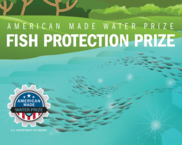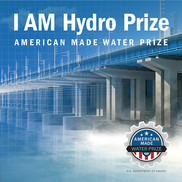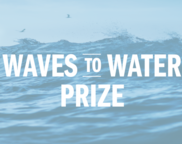|
What’s Inside: This edition of the Water Wire highlights prize updates, upcoming virtual events, STEM Spotlight, and other hot topics.
Continue to follow the Water Wire and emails from WPTO for the latest news and updates from the office. Reach out to WaterPowerTechnologiesOffice@ee.doe.gov with any inquiries or suggestions.
Estimated read time: 6.5 minutes
Prize Updates

Following two days of pitches from nine finalists, DOE and the Bureau of Reclamation announced the three final prize winners of the Fish Protection Prize.
- First place ($200,000 in cash and $100,000 in voucher support from the Pacific Northwest National Laboratory): Benjamin Mater of Alden Research Laboratory and Charles Coutant, a former Oak Ridge National Laboratory Aquatic Ecologist, for their winning concept, Making a Deal with the Devilfish: Biometric-Informed Screening Technology.
- Second place ($125,000 in cash and $100,000 in voucher support from the Pacific Northwest National Laboratory): Nicholas and Kenneth LaBry of Prometheus Innovations LLC for their winning concept, Fish Diversion Material & Inspection Improvements.
- Third place ($75,000 in cash and $100,000 in voucher support from the Pacific Northwest National Laboratory): Sterling Watson and Abe Schneider of Natel Energy for their winning concept, The Center Sender.
The PITCH CONTEST took place at the American Fisheries Society Virtual Annual Meeting. The Fish Protection Prize, a joint venture between the Bureau of Reclamation and WPTO, is administered by the National Renewable Energy Laboratory (NREL) in collaboration with the Pacific Northwest National Laboratory (PNNL). The $700,000 prize cast a wide net, bringing together industry, academia, entrepreneurs, and everyone in between to catalyze new solutions, designs, and strategies to protect fish from water infrastructure, such as water diversions, pipes, and intakes at hydropower dams.
|

WPTO has extended the application period for the I AM Hydro Prize to October 30, 2020. Designed to strengthen hydropower by applying advanced manufacturing technologies that can reduce the costs of components and system designs, the I AM Hydro Prize inspires disruptors and innovators to compete for up to $250,000 in cash prizes. Assistant Secretary for the Office of Energy Efficiency and Renewable Energy (EERE) Daniel R Simmons announced the prize in June.
|

A new addition to WPTO’s prize portfolio, the Groundbreaking Hydro Prize, is officially open and accepting applications until January 31, 2021. This prize challenges competitors to develop new ideas to cut the costs, timelines, and risks associated with geotechnical foundations, which provide structural support for hydropower facilities.
Supported by WPTO and developed by Oak Ridge National Laboratory, the Groundbreaking Hydro Prize was informed by the recently released Hydropower Geotechnical Foundations report, which documents the current state of geotechnical foundation design and construction for hydropower systems.
|

Earlier this summer, WPTO announced 17 winners of the Waves to Water Prize DESIGN Stage. This second stage challenged competitors to develop innovative wave-powered systems that can transform saltwater into drinking water. The incentive? Prizes totaling $3.3 million.
With the conclusion of the DESIGN Stage, competitors will now focus on designing flexible systems to meet the conditions at a specific location—Jennette’s Pier—as part of the ADAPT Stage of the competition. Learn more about the Waves to Water Prize and the winning competitors.
|
On August 28, the Bureau of Reclamation launched a new prize competition to improve short-term streamflow forecasts. The Streamflow Forecast Rodeo competition offers up to $500,000 in prizes to spur streamflow forecasting innovation using technologies such as artificial intelligence, machine learning, and high-performance computing.
Upcoming Webinars & Virtual Events
On October 7, Ocean Observing Prize organizers will share competition updates and successes during a pre-recorded presentation at the Association for Unmanned Vehicle Systems International’s (AUVSI)’s XPONENTIAL 2020 conference. The team will also provide an overview of the prize’s recently announced DEVELOP Competition and provide opportunities for industry to engage with both the competitors and the prize team. The presentation will be available to all attendees through the duration of the conference.
STEM Spotlight
EERE Highlights STEMtember
Science, Technology, Engineering and Mathematics, known as STEM, represent essential building blocks to accomplishing EERE’s mission. This “STEMtember,” EERE is placing a special emphasis on STEM. From workforce development and career opportunities, to educator resources, to collegiate competitions, EERE is a great source of information.
-
Watch this renewable ocean energy video that shows how different devices turn the energy from water and wind into electricity, while underwater power cables carry electricity to shore to power homes, schools, and businesses.
- Check out DOE’s STEM Rising for educational resources for all levels—kindergarten through college students, teachers, and even those already in the workforce. It is never too early or too late to learn.
- For educational resources and information on careers in water power, explore the new STEM portals for Hydropower and Marine Energy. These new digital libraries, supported by WPTO and hosted by NREL, are designed to support educators as well as the next generation of hydropower and marine energy professionals.
-
Check out these interviews with marine energy experts for a peek into what they do day to day.
This month, WPTO opened the application period for the Oak Ridge Institute for Science and Education (ORISE) Marine and Hydrokinetic (MHK) Graduate Student Research Program. Participants will conduct research at both their academic institutions and at an external hosting facility, pursuing research in MHK and supporting the research plan they submitted at the time of application. Participants will spend a minimum of 6 months at the WPTO-approved host facility. The application period is open until December 4, 2020. Learn more about the eligibility requirements, application components, and ORISE program and submit your application today.
In Case You Missed It
On September 10, DOE issued the fiscal year 2021 solicitation for the Technology Commercialization Fund, supported by the Office of Technology Transitions. The Technology Commercialization Fund enables DOE’s applied energy program offices to pursue a strategic, forward-looking approach to commercializing technologies developed at DOE’s National Laboratories.
This month, the U.S. Department of Commerce’s Economic Development Administration announced the winners of its $35 million Build to Scale (B2S) program. As a program partner, WPTO provided $2 million toward the program’s first Industry Challenge, which supports entrepreneurship and accelerates company growth within the Blue Economy.
This month, the U.S. Testing Expertise and Access to Marine Energy Research (TEAMER) program selected 16 projects through its first Request for Technical Support (RFTS). Selected projects will receive technology support with modeling and analysis; laboratory and bench tests; and tank, flume, tunnel, and basin tests. Open-water testing will be available in future RFTS cycles.
Supported by the U.S. Department of Energy (DOE) and directed by the Pacific Ocean Energy Trust (POET), TEAMER is a three-year program designed to provide marine energy technology developers and researchers with access to U.S.-based test facilities and technical expertise.
|